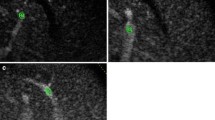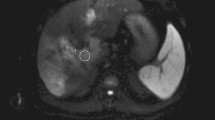Abstract
Purpose
The aims of this prospective study were to evaluate analysis of sulfur-hexafluoride-filled microbubble contrast agent (Sonovue) transit times as a tool for differentiating liver cirrhosis from the noncirrhotic stage of liver disease and to compare its performance with that of conventional B-mode and Doppler ultrasonography (US).
Materials and methods
Contrast-enhanced hepatic ultrasonography with the US contrast agent Sonovue was performed on 38 patients with diagnoses of hepatic cirrhosis based on unequivocal clinical signs or liver biopsy findings (Child-Pugh classes A in 19, B in 16 and C in three), 31 patients with noncirrhotic diffuse liver disease (biopsy confirmed) and 14 controls without diffuse liver disease. Time curves of hepatic-vein signal intensity were analysed using objective criteria to determine the time of enhancement onset (hepatic-vein arrival time) and peak enhancement (hepatic-vein peak enhancement). Accuracy in diagnosing cirrhosis was compared with that based on B-mode and Doppler data.
Results
Hepatic-vein arrival time in cirrhotic patients was significantly shorter (p<0.01) than in noncirrhotic (chronic liver disease and controls) patients. Peak enhancement times in these three groups were not significantly different. An arrival-time cutoff of 17 s distinguished cirrhotic from noncirrhotic patients with high accuracy (100% sensitivity, 93.3% specificity, positive and negative predictive values 92.6% and 100%, respectively) and excellent reproducibility (kappa coefficients of 1.0 and 0.93 for intraand interobserver agreement). Contrast-enhanced US showed better sensitivity than the B-mode and Doppler data.
Conclusions
Analysis of the time of onset of US contrast enhancement of the hepatic vein appears to be a potentially useful noninvasive supplement to conventional sonography and Doppler in the follow-up of patients with chronic diffuse liver disease.
Riassunto
Obiettivo
Lo scopo di questo studio prospettico è stato quello di valutare l’analisi del tempo di transito delle microbolle di mezzo di contrasto costituito da esafluoruro di zolfo (Sonovue) come mezzo per differenziare la cirrosi epatica dagli stadi non cirrotici di malattia e di comparare la sua performance con quella dell’esame B-mode standard e Doppler.
Materiali e metodi
È stato effettuato l’esame ecografico del fegato con mezzo di contrasto Sonovue in 38 pazienti con diagnosi di cirrosi basata su segni clinici inequivocabili o su biopsia epatica (Child-Pugh A in 19 pazienti, B in 16 e C in 3). Sono stati analizzati inoltre 31 pazienti con patologia cronica diffusa non cirrotica (confermata dalla biopsia), e 14 pazienti di controllo senza patologia epatica. Sono stati analizzati i diagrammi tempo/intensità di segnale della vena sovraepatica utilizzando criteri oggettivi per determinare il tempo di inizio dell’enhancement (tempo di arrivo della vena sovraepatica) e il picco di enhancement (tempo di picco della vena sovraepatica). L’accuratezza nella diagnosi di cirrosi è stata confrontata con quella basata sui dati B-mode e Doppler.
Risultati
Il tempo di arrivo della vena sovraepatica nei pazienti cirrotici è risultato significativamente pi`u breve (p<<0,01) rispetto ai pazienti non cirrotici (patologia epatica cronica e controlli). Il tempo di picco di enhancement in questi tre gruppi non è risultato significativo. Un tempo cut-off di arrivo di 17 secondi ha distinto pazienti cirrotici da quelli non cirrotici con elevata accuratezza (100% sensitività, 93,3% specificità, valore predittivo positivo e negativo: 92,6% e 100%, rispettivamente) ed eccellente riproducibilità (coefficiente κ di 1,0 e 0,93 per l’accordo intra-ed interosservatore). L’ecografia con mezzo di contrasto ha mostrato una migliore sensibilità rispetto all’esame B-mode e Doppler.
Conclusioni
L’analisi del tempo di inizio dell’enhancement contrastografico della vena sovraepatica appare un potenziale e non invasivo supplemento all’ecografia convenzionale e all’esame Doppler nel follow-up di pazienti con patologia epatica cronica diffusa.
Similar content being viewed by others
References
Schrier RW (1988) Pathogenesis of sodium and water retention in highoutput and low-output cardiac failure, nephritic syndrome, cirrhosis and pregnancy. N Engl J Med 319:1065–1072
Lautt WW (1985) Mechanism and role of intrinsic regulation of hepatic arterial blood flow: hepatic buffer response. Am J Physiol 249:G549–G556
Kleber G, Steudel N, Behrmann C et al (1999) Hepatic arterial flow volume and reserve in patients with cirrhosis: use of intra-arterial Doppler and adenosine infusion. Gastroenterology 116:906–914
Ohnishi K, Chin N, Saito M et al (1986) Portographic opacification of hepatic veins and (anomalous) anastomoses between the portal and hepatic veins in cirrhosis-indication of extensive intrahepatic shunts. Am J Gastroenterol 81:975–978
Rockey DC, Weisiger RA (1996) Endothelin-induced contractility of stellate cells from normal and cirrhotic rat liver: implications for regulation of portal pressure and resistance. Hepatology 24:233–240
Rockey D (1997) The cellular pathogenesis of portal hypertension: stellate cell contractility, endothelin, and nitric oxide. Hepatology 25:2–5
Popper H, Elias H, Petty DE (1952) Vascular pattern of the cirrhotic liver. Am J Clin Path 22:717
Colli A, Fraquelli M, Andreoletti M et al (2003) Severe liver fibrosis or cirrhosis: accuracy of US for detection-analysis of 300 cases. Radiology 227:89–94
Nishiura T, Watanabe H, Ito M et al (2005) Ultrasound evaluation of the fibrosis stage in chronic liver disease by the simultaneous use of low and high frequency probes. Br J Radiol 78:189–197
Hung CH, Lu SN, Wang JH et al (2003) Correlation between ultrasonographic and pathologic diagnoses of hepatitis B and C virusrelated cirrhosis. J Gastroenterol38:153–157
Shen L, Li JQ, Zeng MD et al (2006) Correlation between ultrasonographic and pathologic diagnosis of liver fibrosis due to chronic virus hepatitis. World J Gastroenterol 12:1292–1295
D’Onofrio M, Martone E, Brunelli S et al (2005) Accuracy of ultrasound in the detection of liver fibrosis in chronic viral hepatitis. Radiol Med (Torino)110:341–348
Winkfield B, Aubé C, Burtin P, Calès P (2003) Inter-observer and intraobserver variability in hepatology. Eur J Gastroenterol Hepatol 15:959–966
Bernatik T, Strobel D, Hahn EG, Becker D (2002) Doppler measurements: a surrogate marker of liver fibrosis? Eur J Gastroenterol Hepatol 14:383–387
Schwarz KQ, Bezante GP, Chen X et al (1993) Quantitative echo contrast concentration measurement by Doppler sonography. Ultrasound Med Biol 19:289–297
Blomley MJ, Cooke J, Unger EC et al (2001) Microbubble contrast agents: a new era in ultrasound. BMJ 322:1222–1225
Blomley M, Albrecht T, Cosgrove D et al (1998) Stimulated acoustic emission in liver parenchyma with Levovist. Lancet 351:568–572
Albrecht T, Blomley MJ, Cosgrove DO et al (1999) Non-invasive diagnosis of hepatic cirrhosis by transit-time analysis of an ultrasound contrast agent. Lancet353:1579–1583
Blomley MJ, Lim AKP, Harvey CJ et al (2003) Liver microbubble transit time compared with histology and Child-Pugh score in diffuse liver disease: cross sectional study. Gut 52:1188–1193
Maruyama H, Matsunani S, Saisho H et al (2004) Different behaviours of microbubbles in the liver: time-related quantitative analysis of two ultrasound contrast agents, Levovist and Definity. Ultrasound Med Biol 30:1035–1040
Lim AK, Patel N, Eckersley RJ et al (2006) Hepatic vein transit time of SonoVue: a comparative study with Levovist. Radiology 240:130–135
Oberti F, Valsesia E, Pilette C et al (1997) Noninvasive diagnosis of hepatic fibrosis or cirrhosis. Gastroenterology 113:1609–1616
Giannini E, Botta F, Borro P et al (2003) Platelet count/spleen diameter ratio: proposal and validation of a noninvasive parameter to predict the presence of oesophageal varices in patients with liver cirrhosis. Gut 52:1200–1205
Child CG, Turcotte JG (1964) Surgery and portal hypertension. In: Child CG (ed) The liver and portal hypertension, Volume 1 in the Major Problems in Clinical Surgery. WB Saunders Company, Oxford, pp 1–85
Kamath PS, Wiesner RH, Malinchoc M et al (2001) A model to predict survival in patients with end-stage liver disease. Hepatology 33:464–470
Knodell RG, Ishak KG, Black WC et al (1981) Formulation and application of a numerical scoring system for assessing histological activity in asymptomatic chronic active hepatitis. Hepatology 1:431–435
Moriyasu F, Nishida O, Ban N et al (1986) “Congestion Index” of the portal vein. AJR Am J Roentgenol 146:735–739
de Franchis R, Merkel C, Bolondi L et al Linee guida A.I.S.F. per l’ipertensione portale. www.webaisf.org
Van Ness MM, Diehl AM (1989) Is liver biopsy useful in the evaluation of patients with chronically elevated liver enzymes? Ann Intern Med 111:473–478
Wilson JF (2005) Liver cancer on the rise. Ann Intern Med 142:1029–1032
de Franchis R, Dell’Era A (2007) Noninvasive diagnosis of cirrhosis and the natural history of its complications. Best Pract Res Clin Gastroenterol 21:3–18
Sugimoto H, Kaneko T, Hirota M et al (2002) Earlier hepatic vein transit-time measured by contrast ultrasonography reflects intrahepatic hemodynamic changes accompanying cirrhosis. J Hepatol 37:578–583
Lim AK, Taylor-Robinson SD, Patel N et al (2005) Hepatic vein transit times using a microbubble agent can predict disease severity non-invasively in patients with hepatitis C. Gut 54:128–133
Adler J, Goodgold M, Mitty H et al (1978) Arteriovenous shunts involving the liver. Radiology 129:315–322
Author information
Authors and Affiliations
Corresponding author
Rights and permissions
About this article
Cite this article
Abbattista, T., Ridolfi, F., Ciabattoni, E. et al. Diagnosis of liver cirrhosis by transit-time analysis at contrast-enhanced ultrasonography. Radiol med 113, 860–874 (2008). https://doi.org/10.1007/s11547-008-0292-3
Received:
Accepted:
Published:
Issue Date:
DOI: https://doi.org/10.1007/s11547-008-0292-3




